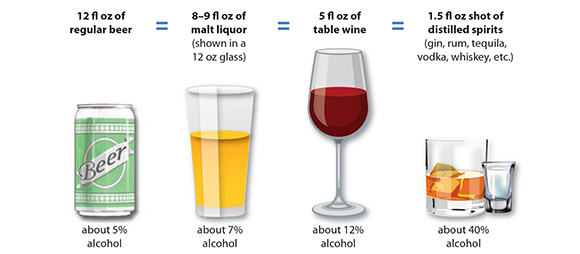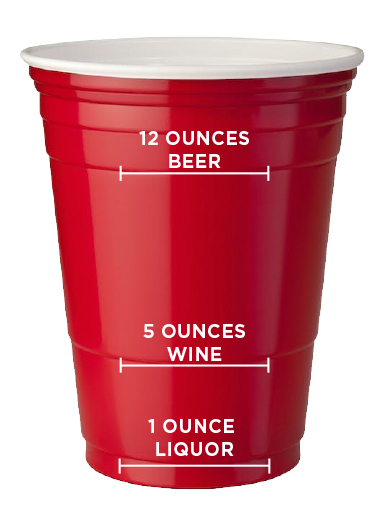Alcohol 101
A Responsible Drinking Guide for Lobos!
Not all Lobos chose to drink while in college, but for those who do, we’d like to let you know that we’ve surveyed your peers, and the consensus is Lobos party smart! If you decide to drink while at UNM, we're here to help you make smart choices so that you stay on track to graduation. Below is our Responsible Drinking Guide for Lobos!
What is a Standard Drink?
Most college students are surprised to learn what counts as a standard drink. In the United States, a “standard” drink is any drink that contains about 0.6 fluid ounces or 14 grams of “pure” alcohol. Although the drinks pictured below are different sizes, each contains approximately the same amount of alcohol and counts as a single drink.

Source: National Institute on Alcohol Abuse & Alcoholism
Know How Much is in Your Cup
Did you know that you can use the lines on a solo cup to measure standard drinks of alcohol? If you’re at a party, don't be clueless about how much you're actually drinking. By knowing what's in your cup, you can keep track of your drinks and proceed to drink responsibly!

What is More Than a Standard Drink?
Here are some examples of what counts as more than a standard drink:
- A pint of draft beer
- A red solo cup filled to the top
- A cooler
- A cocktail such as a martini
- A cup of jungle juice
- A big gulp cup
What is Binge Drinking?
Binge drinking is defined as a pattern of drinking that brings a person's blood alcohol concentration (BAC) to 0.08 grams percent or above. This typically happens when men consume 5 or more drinks within a 2-hour period and when women consume 4 or more drinks within a 2-hour period. Binge drinking is dangerous because it can lead to regretful or harmful situations, physical injuries and also a variety of health problems.
What is Blood Alcohol Concentration (BAC)?
Blood alcohol concentration (BAC) is the amount of alcohol in your blood stream. Check out our BAC Calculator – it can help you understand how many drinks you can have before your BAC gets too close to 0.08 (the legal limit of intoxication). The chart below shows you the side-effects you can expect to experience based on how high your BAC is.

Source: Syracuse University
Myths and Facts About Alcohol
Myth 1: “I can sober up quickly if I need to.”
Fact: The only thing that sobers us up is TIME. It takes about 2 hours for the adult body to eliminate the alcohol content of a single drink, depending on your weight. Nothing can speed up this process, not even coffee or cold showers.
Myth 2: “The more alcohol I have the better!”
Fact: Alcohol is a biphasic drug. At low levels it brings on euphoria, but in larger amounts it brings more harm that fun (vomiting, blackouts, etc.).
Myth 3:“I can drink and still be in control.”
Fact: Drinking impairs your judgement, which increases the likelihood that you will do something you’ll later regret such as having unprotected sex, being involved in date rape, damaging property, or being victimized by others.
Myth 4: “I can drive after a few drinks, no problem.”
Fact: More than ½ of all crashes among 18-24 year-olds involve alcohol. The effects of alcohol start sooner than people realize, with mild impairment (up to .05 BAC) starting to affect speech, memory, attention, coordination, and balance.
Myth 5: “It’s okay for me to drink to keep up with my boyfriend.”
Fact: Women process alcohol differently. No matter how much he drinks, if you drink the same amount as your boyfriend, you will be more intoxicated and more impaired.
Myth 6: Beer doesn’t have as much alcohol as hard liquor.
Fact: A 12-ounce bottle of beer has the same amount of alcohol as a standard shot of 80-proof liquor (either straight or in a mixed drink) or 5 ounces of wine.
Source: collegedrinkingprevention.gov
Alcohol Poisoning
Alcohol poisoning is a medical emergency. By knowing what to look for, you could save a life! If you suspect someone has had too much to drink:
- DO NOT LEAVE THE PERSON ALONE. Blood alcohol levels can continue to rise even after a person has passed out, so check on him/her often.
- Try to wake the person up.
- Place the person in fetal position with pillow at the back to prevent rolling to avoid the person choking on his/her own vomit.
- Check for regular or shallow breathing.
- Check for blue lips or pale skin.
- Do not put a person in a cold shower – it can cause the person to go into physical shock.
- Coffee will not sober a person up – the only thing that can sober someone up is TIME.
- Do not hesitate to call 911.
Call 911 immediately if the person is:
- Unconscious, cannot be woken up or can only be awakened for a short time
- Unaware of surroundings
- Exhibits respiratory difficulties, including slow, labored breathing (10 breaths per minute or less is a MEDICAL EMERGENCY).
- Blue under the fingernails or at gums
- Cold, clammy, and/or bluish skin
- Vomiting while semiconscious or unconscious
Source: NMSU Wave
Responsible Drinking - Safe Party Tips
- Know how much alcohol you’re drinking and keep track of your drinks (Some mixed drinks have 2+ shots).
- Set your drink limit in advance and stick to it.
- Plan ahead and designate a sober driver or use a safe ride such as Uber or Lyft.
- Alternate alcoholic drinks with water.
- Eat food before and while drinking.
- Pace yourself to one drink per hour.
- Avoid drinking games and avoid losing control.
- Always keep an eye on your drink.
- Have a friend let you know when you’ve had too much to drink.
- Stick with the same group of friends.
- Never consume alcohol while taking prescription medication without consulting a medical professional.
Now that you’ve read through our Responsible Drinking Guide, we hope that you’ll remember this information and make responsible choices when it comes to drinking. Lobos party smart – stay with the pack!
